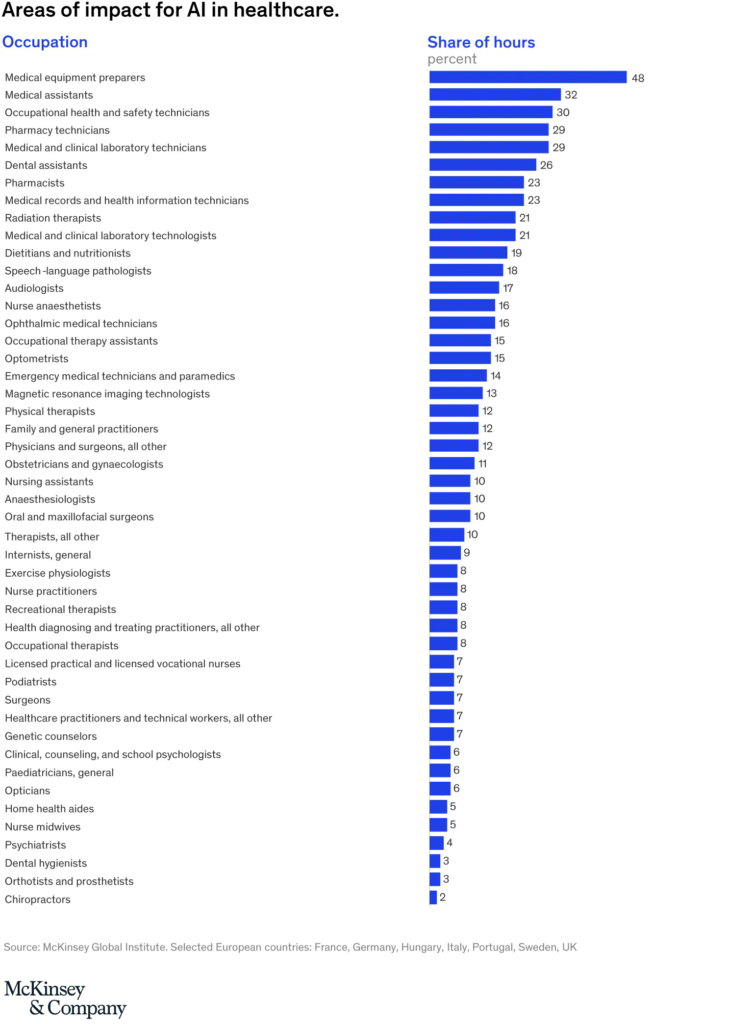How will automation and AI affect the number of jobs in healthcare? The reality is that the AI healthcare sector faces a significant workforce gap that is only expected to widen.
The World Health Organization estimates overall demand for healthcare workers to rise to 18.2 million across Europe by 2030 and, as an example, states that the current supply of 8.6 million nurses, midwives, and healthcare assistants across Europe will not meet current or projected future need.
Create new workflows that integrate AI
According to McKinsey Report, designers specializing in human-machine interactions on clinical decision making will help create new workflows that integrate AI. Data architects will be critical in defining how to record, store and structure clinical data so that algorithms can deliver insights, while leaders in data governance and data ethics will also play vital roles.
In other data-rich areas, such as genomics, new professionals would include ‘hybrid’ roles, such as clinical bioinformaticians, specialists in genomic medicine, and genomic counsellors. Institutions will have to develop teams with expertise in partnering with, procuring, and implementing AI products that have been developed or pioneered by other institutions.
The MGI analysis of the demand for specific types of healthcare activities suggests significant increases in the need for specific professionals, such as licensed practical and vocational nurses, home health aides, and others, who are core to the day-to-day delivery of care to European citizens.
Automation could and AI
It highlights that automation could, in fact, alleviate workforce shortages in healthcare, as demand for occupations is set to increase. For example, a 39 percent increase in all nursing occupations is expected by 2030, even allowing for the fact that approximately 10 percent of nursing activities could be freed up by automation.
The MGI has studied how automation and AI are likely to affect the future of work. It concludes that automation will affect most jobs across sectors, but the degree varies significantly, and healthcare is one of the sectors with the lowest overall potential for automation—only 35 percent of time spent is potentially automatable and this varies by type of occupation. The potential for automation is different to the likelihood of adoption.
The analysis uses a midpoint scenario, which estimates that 15% of current work hours in healthcare are expected to be automated. Exhibit =shows the share of hours currently worked that could be freed up by automation by 2030 for a wide range of healthcare occupations in selected European countries. This does not reflect the potential for further disruption through other factors, such as personalization, that may revolutionize healthcare by focusing on a “segment of one.”
Impact for AI in Healthcare

The impact on the workforce will be much more than jobs lost or gained—the work itself will change. At the heart of any change is the opportunity to refocus on and improve patient care.
AI can help remove or minimize time spent on routine
AI can augment a range of clinical activities and help healthcare practitioners access information that can lead to better patient outcomes and higher quality of care. It can improve the speed and accuracy in use of diagnostics, give practitioners faster and easier access to more knowledge, and enable remote monitoring and patient empowerment through self-care.
AI can help remove or minimize time spent on routine, administrative tasks, which can take up to 70% of a healthcare practitioner’s time. A recurring theme in interviews was that this type of AI role would not just be uncontroversial but would top of most people’s wish list and would speed up adoption. AI can go further.
This will all require bringing new activities and skills into the sector, and it will change healthcare education—shifting the focus away from memorizing facts and moving to innovation, entrepreneurship, continuous learning, and multidisciplinary working.
The biggest leap of all will be the need to embed digital and AI skills within healthcare organizations—not only for physicians to change the nature of consultations, but for all frontline staff to integrate AI into their workflow. This is a significant change in organizational culture and capabilities, and one that will necessitate parallel action from practitioners, organizations and systems all working together.
Effect on the AI workforce
The final effect on the workforce will be the introduction of new professionals. Multiple roles will emerge at the intersection of medical and data-science expertise.
For example, medical leaders will have to shape clinically meaningful and explainable AI that contains the insights and information to support decisions and deepen healthcare professionals’ understanding of their patients. Clinical engagement will also be required in product leadership, in order to determine the contribution of AI-based decision-support systems within broader clinical protocols.
Orchestrating the introduction of new specializations coming from data science and engineering within healthcare delivery will become a critical skill in itself. There will be an urgent need for health systems to attract and retain such scarce and valuable talent, for example, by developing flexible and exciting career paths and clear routes to leadership roles.








